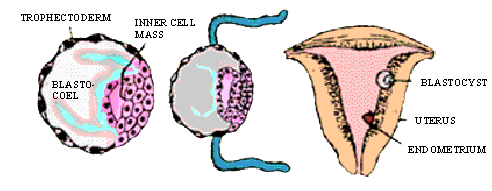|
PinkMonkey Online Study Guide-Biology

(C) Morula
(D) Blastocyst
Figure 24.10 Early stages in development of an
embryo
The union of the sperm nucleus and the nucleus of the
ovum to form a zygote is known as fertilization. It normally occurs
in outer part of the uterine tube, i.e. in Fallopian tube, usually within
24 hours after ovulation. The spermatozoa swim up the female tract by
movements of their flagella (tails), and is also assisted by muscular
contractions of the uterus.
The spermatozoa must remain
in the female genital tract for 4-6 hours. During this time they
are activated by the secretion of the enzyme hyaluronidase
to form finger-like projection called an acrosome. The enzyme partially
dissolves the membrane covering of the ovum for the entry of the
sperm via insertion of its acrome. Normally, only one spermatozoan
fertilizes an ovum. After the entry of the sperm the tail
is shed, the second polar body is cut off within the perivitelline
space, the fertilization membrane is formed around the ovum which
prevents the entry of other sperms, chromosomes are rearranged within
the female pronucleus, the male pronucleus rotates through 180o
angle and gradually approaches the female pronucleus, the union
of the male and female pronuclei takes place exactly in the center
of the cell to form a single segmentation nucleus or zygote,
a process termed fertilization. The zygote contains the diploid
number of chromosomes (46).
Cleavage (Figure 24.10). The zygote undergoes
rapid cell division as it passes down the oviduct and into the uterus.
This early division of the zygote is called cleavage. The cleavage
is total or holoblastic, and takes place at regular intervals.
The dividing zygote floats freely, absorbing nutrients from the uterine
secretions. The cleavage or segmentation continues (mitotic type), and
results in the formation a solid mass of cells known as the morula.
The morula arrives at the uterus about 5 days after fertilization. The
uterine fluid enters the morula and provides nutritive elements at this
stage. If the two first-formed cells of one zygote part, they develop
into identical twins. If two ova are fertilized simultaneously,
they form fraternal twins.

Click here for enlargement
|
(E) Blastocyst | Blastocyst embedded in endometrium | (F) Implantation |
Figure 24. 11 Furthur Development of the Embryo
Blastula - The fluid imbibed by the morula, develops
into a fluid filled cavity called the blastocoel. The blastocoel
splits the cell mass into an inner cell mass and an outer layer
of cells, the trophoblast (strophectoderm). The morula at this stage is
called the blastocyst or the blastula (Figure 24.11). The inner
cell mass will develop into the embryo, and the trophoblast forms
an encompassing sac that becomes part of the placenta.
[next page]
|
Table of Contents
24.0 Introduction
24.1 Human reproduction
24.2 Female reproductive cycle
24.3 Embryonic Development
Chapter 25
|